TOYOTA CAMRY HYBRID 2021 Owners Manual (in English)
Manufacturer: TOYOTA, Model Year: 2021, Model line: CAMRY HYBRID, Model: TOYOTA CAMRY HYBRID 2021Pages: 624, PDF Size: 15.98 MB
Page 321 of 624

3214-5. Using the driving support systems
4
Driving
For vehicles sold in Canada
Page 322 of 624

3224-5. Using the driving support systems
WARNING
■Handling the radar sensor
One Blind Spot Monitor sensor is installed inside the left and right side of
the vehicle rear bumper respectively. Observe the following to ensure the
Blind Spot Monitor can function correctly.
If the warning message does not disappear, have the vehicle inspected
by your Toyota dealer.
● Do not subject a sensor or its surrounding area on the rear bumper to a
strong impact.
If a sensor is moved even slightly off position, the system may malfunction
and vehicles may not be detected correctly.
In the following situations, have your vehicle inspected by you r Toyota
dealer.
• A sensor or its surrounding area is subject to a strong impact .
• If the surrounding area of a sensor is scratched or dented, or part of them has become disconnected.
● Do not disassemble the sensor.
● Do not attach accessories or stickers to the sensor or surrounding area on
the bumper.
● Do not modify the sensor or surrounding area on the bumper.
● Do not paint the rear bumper any color other than an official Toyota color.
●Keep the sensor and its surrounding
area on the bumper clean at all times.
If a sensor or its surrounding area on
the rear bumper is dirty or covered with
snow, the Blind Spot Monitor may not
operate and a warning message ( P.
320) will be displayed.
In this situation, clear off the dirt or
snow and drive the vehicle with the
operation conditions of the BSM func-
tion ( P. 325) satisfied for approxi-
mately 10 minutes.
Page 323 of 624
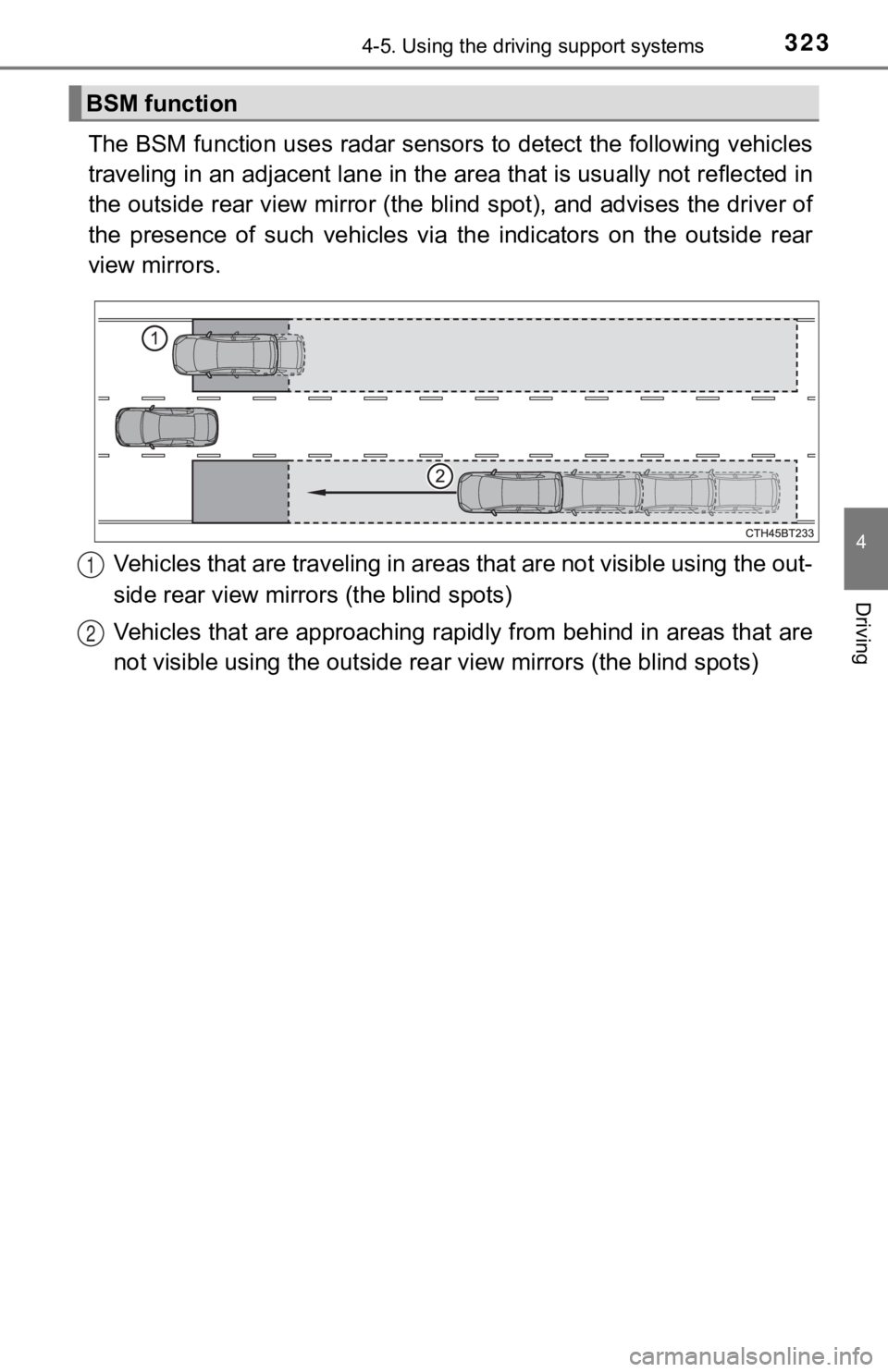
3234-5. Using the driving support systems
4
Driving
The BSM function uses radar sensors to detect the following vehicles
traveling in an adjacent lane in the area that is usually not r eflected in
the outside rear view mirror (the blind spot), and advises the driver of
the presence of such vehicles via the indicators on the outside rear
view mirrors.
Vehicles that are traveling in areas that are not visible using the out-
side rear view mirrors (the blind spots)
Vehicles that are approaching rapidly from behind in areas that are
not visible using the outside re ar view mirrors (the blind spots)
BSM function
1
2
Page 324 of 624
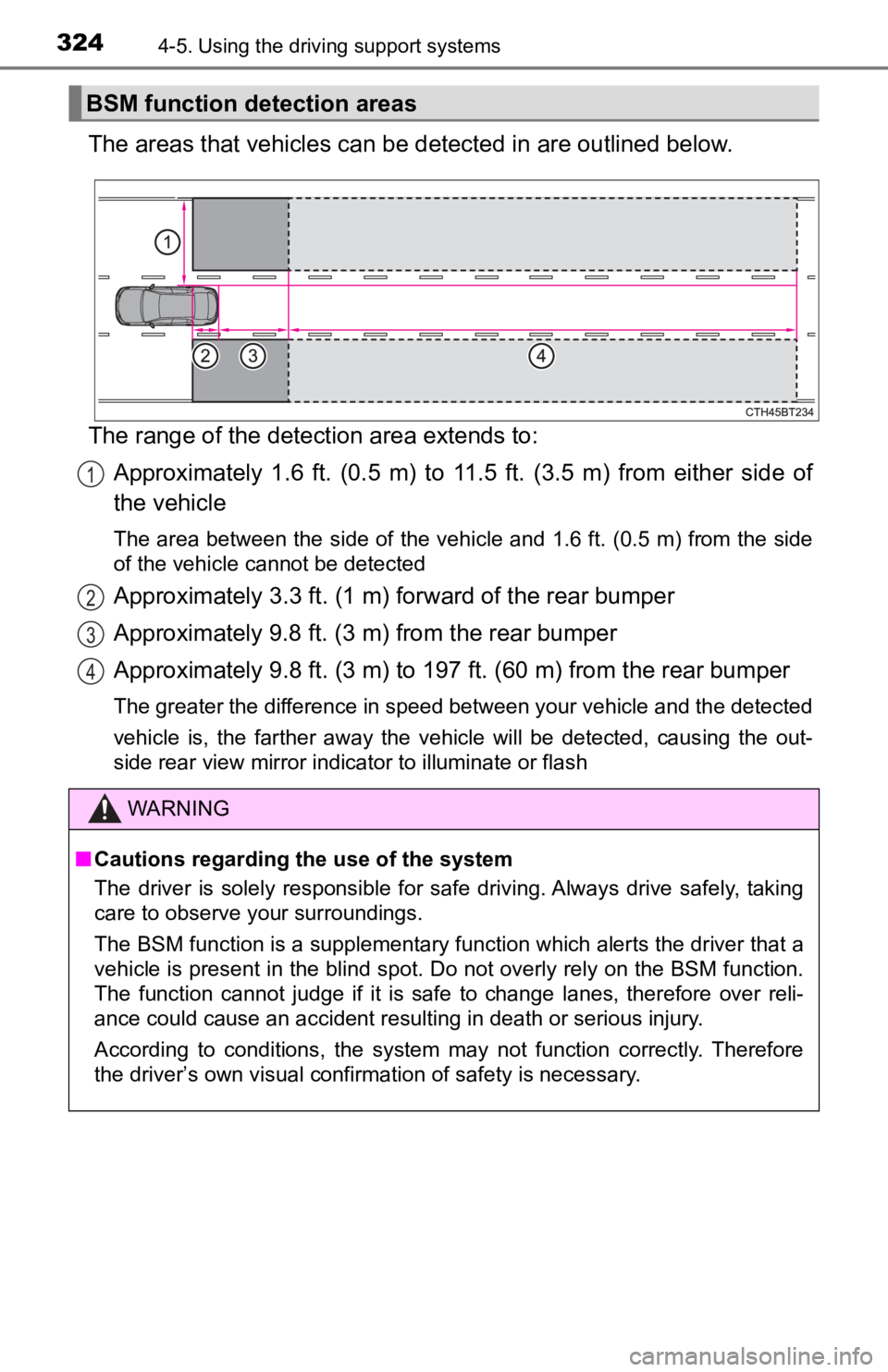
3244-5. Using the driving support systems
The areas that vehicles can be detected in are outlined below.
The range of the detecti on area extends to:
Approximately 1.6 ft. (0.5 m) to 11.5 ft. (3.5 m) from either s ide of
the vehicle
The area between the side of the vehicle and 1.6 ft. (0.5 m) fr om the side
of the vehicle cannot be detected
Approximately 3.3 ft. (1 m) f orward of the rear bumper
Approximately 9.8 ft. (3 m) from the rear bumper
Approximately 9.8 ft. (3 m) to 19 7 ft. (60 m) from the rear bumper
The greater the difference in speed between your vehicle and the detected
vehicle is, the farther away the vehicle will be detected, causing the out-
side rear view mirror indicator to illuminate or flash
BSM function detection areas
1
2
3
4
WARNING
■Cautions regarding the use of the system
The driver is solely responsible for safe driving. Always drive safely, taking
care to observe your surroundings.
The BSM function is a supplementary function which alerts the d river that a
vehicle is present in the blind spot. Do not overly rely on the BSM function.
The function cannot judge if it is safe to change lanes, theref ore over reli-
ance could cause an accident resulting in death or serious inju r y.
According to conditions, the system may not function correctly. Therefore
the driver’s own visual confirmation of safety is necessary.
Page 325 of 624

3254-5. Using the driving support systems
4
Driving
■The BSM function is operational when
●The BSM function is turned on
● Vehicle speed is greater than approximately 10 mph (16 km/h).
■ The BSM function will detect a vehicle when
●A vehicle in an adjacent lane overtakes your vehicle.
● Your vehicle overtakes a vehicle in an adjacent lane slowly.
● Another vehicle enters the detection area when it changes lanes .
■ Conditions under which the BSM function will not detect a vehic le
The BSM function is not designed to detect the following types of vehicles
and/or objects:
● Small motorcycles, bicycles, pedestrians, etc.
*
●Vehicles traveling in the opposite direction
● Guardrails, walls, signs, parked vehicles and similar stationar y objects
*
●Following vehicles that are in the same lane*
●Vehicles driving 2 lanes across from your vehicle*
●Vehicles which are being overtaken rapidly by your vehicle
*: Depending on the conditions, detection of a vehicle and/or obj ect may
occur.
■ Conditions under which the BSM function may not function correc tly
● The BSM function may not detect vehicles correctly in the following condi-
tions:
• When the sensor is misaligned due to a strong impact to the se nsor or its
surrounding area
• When driving on a road surface that is wet with standing water during bad
weather, such as heavy rain, snow, or fog
• When mud, snow, ice, a sticker, etc. is covering the sensor or surround-
ing area on the rear bumper
• When there is a significant difference in speed between your v ehicle and
the vehicle that enters the detection area
• When a vehicle is in the detection area from a stop and remains in the
detection area as your vehicle accelerates
• When driving up or down consecutive steep inclines, such as hills, a dip on the road, etc.
• When driving on roads with sharp bends, consecutive curves, or uneven
surfaces
• When multiple vehicles are approaching with only a small gap between
each vehicle
• When vehicle lanes are wide, or when driving on the edge of a lane, and
the vehicle in an adjacent lane is far away from your vehicle
• When the vehicle that enters the detection area is traveling a t about the
same speed as your vehicle
• When there is a significant difference in height between your vehicle and
the vehicle that enters the detection area
Page 326 of 624

3264-5. Using the driving support systems
• Directly after the BSM function is turned on
● Instances of the BSM function unnecessarily detecting a vehicle and/or
object may increase under the following conditions:
• When the sensor is misaligned due to a strong impact to the se nsor or its
surrounding area
• When the distance between your vehicle and a guardrail, wall, etc. that
enters the detection area is short
• When there is only a short distance between your vehicle and a following
vehicle
• When vehicle lanes are narrow, or when driving on the edge of a lane, and a vehicle traveling in a lane other than the adjacent lanes enters the
detection area
• When items such as a bicycle carrier are installed on the rear of the vehi-
cle
• When driving up and down consecutive steep inclines, such as hills, dips
on the road, etc.
• When driving on roads with sharp bends, consecutive curves, or uneven
surfaces
Page 327 of 624
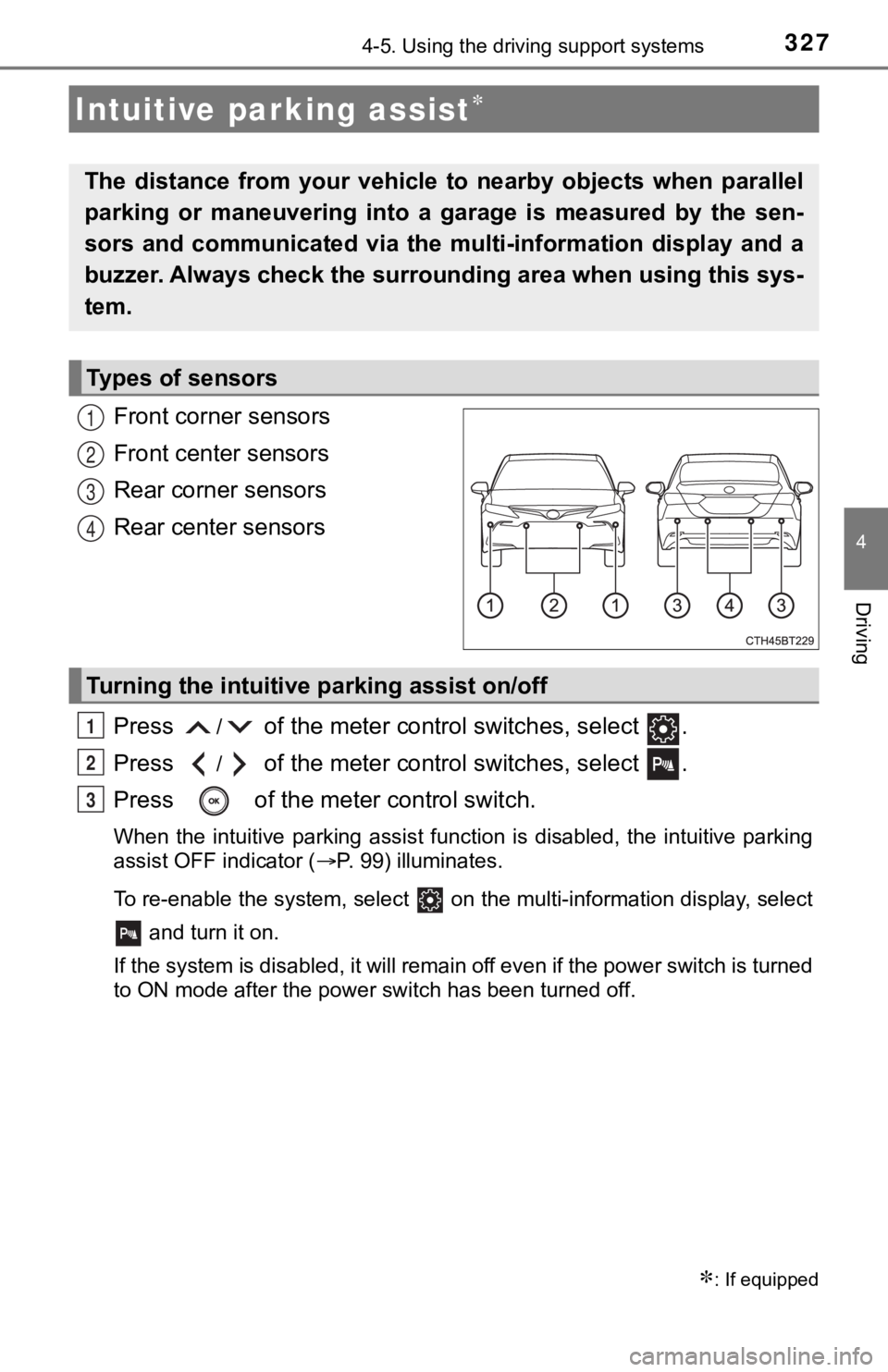
3274-5. Using the driving support systems
4
Driving
Front corner sensors
Front center sensors
Rear corner sensors
Rear center sensors
Press
/ of the meter control switches, select .
Press
/ of the meter control switches, select .
Press of the meter control switch.
When the intuitive parking assist function is disabled, the int uitive parking
assist OFF indicator ( P. 99) illuminates.
To re-enable the system, select on the multi-information display, select and turn it on.
If the system is disabled, it will remain off even if the power switch is turned
to ON mode after the power switch has been turned off.
Intuitive parking assist
: If equipped
The distance from your vehicle to nearby objects when parallel
parking or maneuvering into a garage is measured by the sen-
sors and communicated via the multi-information display and a
buzzer. Always check the surro unding area when using this sys-
tem.
Types of sensors
1
2
3
4
Turning the intuitive parking assist on/off
1
2
3
Page 328 of 624
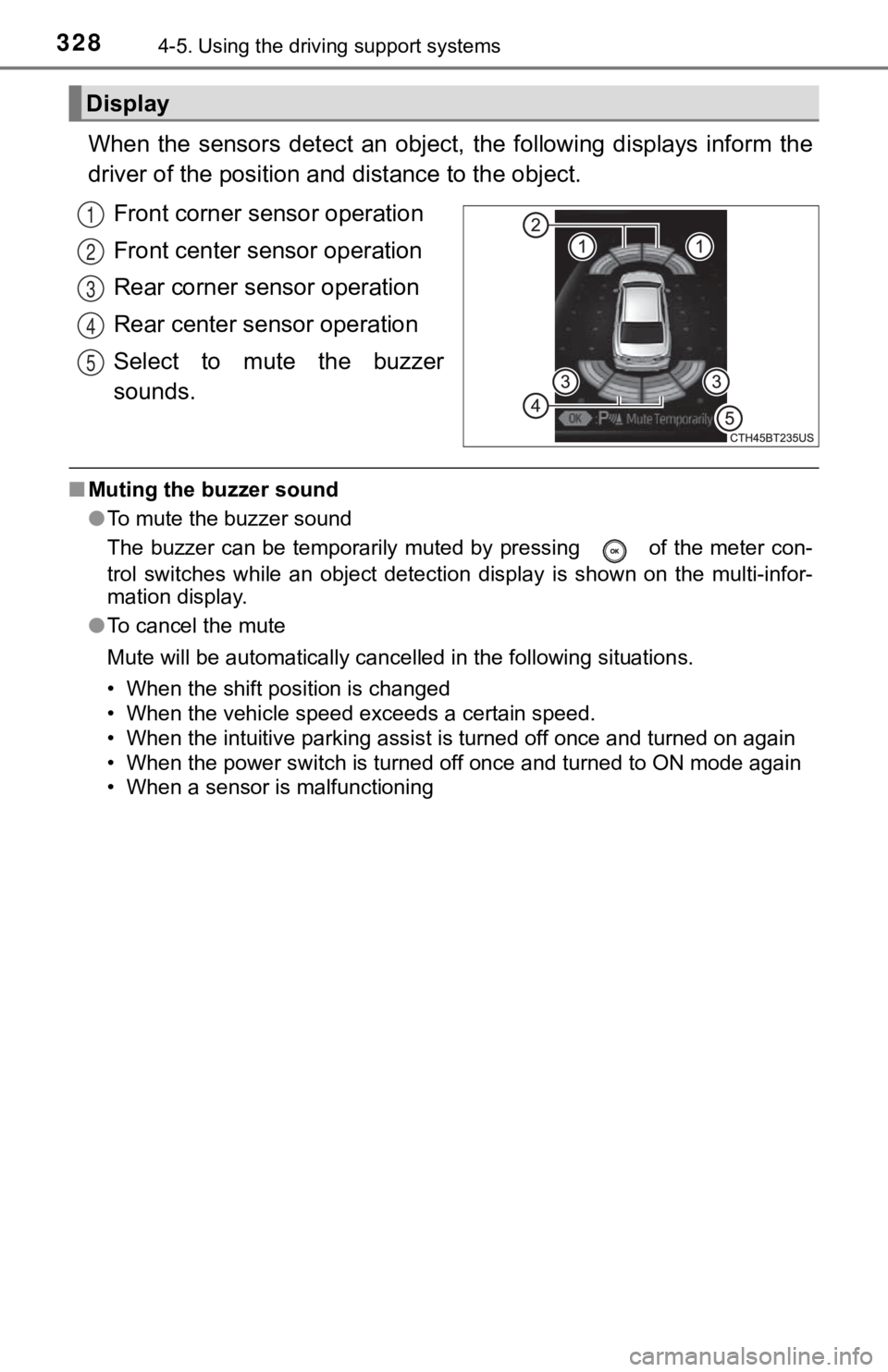
3284-5. Using the driving support systems
When the sensors detect an object, the following displays infor m the
driver of the position a nd distance to the object.
Front corner sensor operation
Front center sensor operation
Rear corner sensor operation
Rear center sensor operation
Select to mute the buzzer
sounds.
■ Muting the buzzer sound
●To mute the buzzer sound
The buzzer can be temporarily muted by pressing of the meter c on-
trol switches while an object detection display is shown on the multi-infor-
mation display.
● To cancel the mute
Mute will be automatically cancelled in the following situation s.
• When the shift position is changed
• When the vehicle speed exceeds a certain speed.
• When the intuitive parking assist is turned off once and turned on again
• When the power switch is turned off once and turned to ON mode again
• When a sensor is malfunctioning
Display
1
2
3
4
5
Page 329 of 624
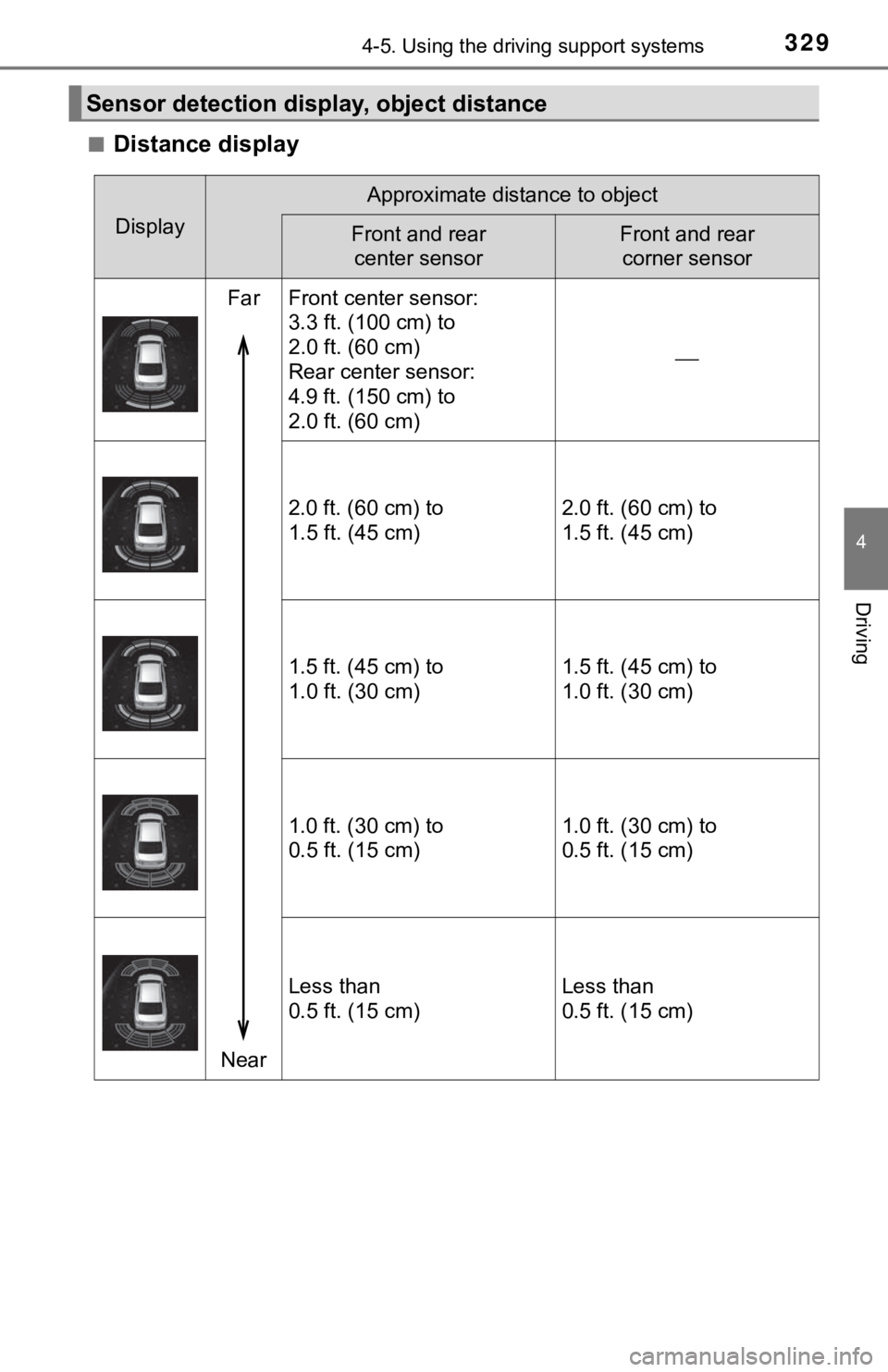
3294-5. Using the driving support systems
4
Driving
■Distance display
Sensor detection display, object distance
Display
Approximate distance to object
Front and rear
center sensorFront and rear corner sensor
Far
Near Front center sensor:
3.3 ft. (100 cm) to
2.0 ft. (60 cm)
Rear center sensor:
4.9 ft. (150 cm) to
2.0 ft. (60 cm)
2.0 ft. (60 cm) to
1.5 ft. (45 cm)2.0 ft. (60 cm) to
1.5 ft. (45 cm)
1.5 ft. (45 cm) to
1.0 ft. (30 cm)1.5 ft. (45 cm) to
1.0 ft. (30 cm)
1.0 ft. (30 cm) to
0.5 ft. (15 cm)1.0 ft. (30 cm) to
0.5 ft. (15 cm)
Less than
0.5 ft. (15 cm)Less than
0.5 ft. (15 cm)
Page 330 of 624
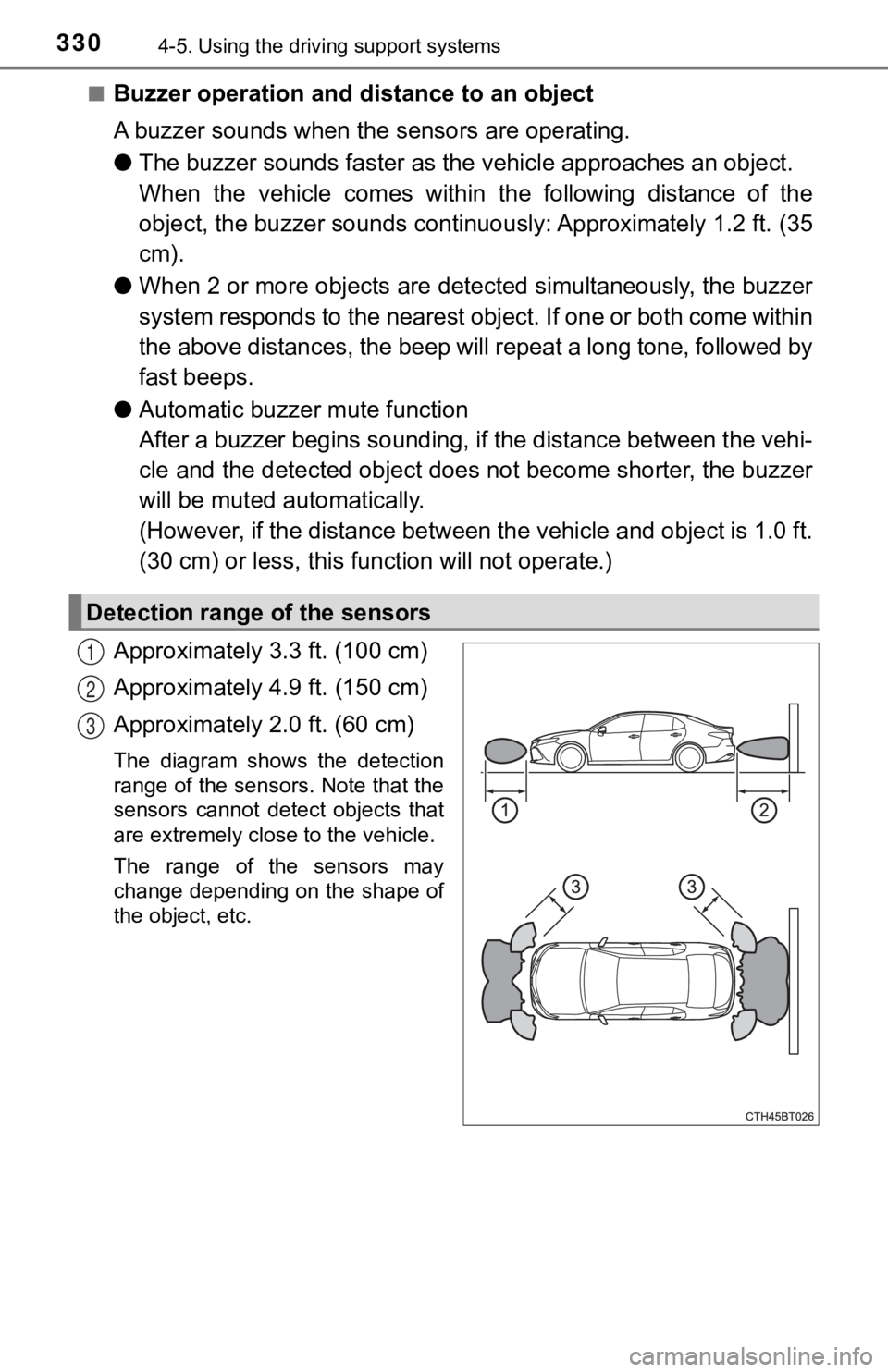
3304-5. Using the driving support systems
■Buzzer operation and distance to an object
A buzzer sounds when the sensors are operating.
● The buzzer sounds faster as the vehicle approaches an object.
When the vehicle comes within the following distance of the
object, the buzzer sounds continuo usly: Approximately 1.2 ft. (35
cm).
● When 2 or more objects are detec ted simultaneously, the buzzer
system responds to the nearest object. If one or both come with in
the above distances, the beep will repeat a long tone, followed by
fast beeps.
● Automatic buzzer mute function
After a buzzer begins sounding, if the distance between the veh i-
cle and the detected object does not become shorter, the buzzer
will be muted automatically.
(However, if the distance between the vehicle and object is 1.0 ft.
(30 cm) or less, this function will not operate.)
Approximately 3.3 ft. (100 cm)
Approximately 4.9 ft. (150 cm)
Approximately 2.0 ft. (60 cm)
The diagram shows the detection
range of the sensors. Note that the
sensors cannot detect objects that
are extremely close to the vehicle.
The range of the sensors may
change depending on the shape of
the object, etc.
Detection range of the sensors
1
2
3